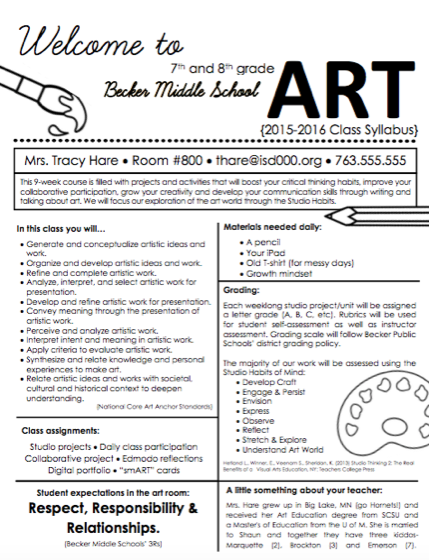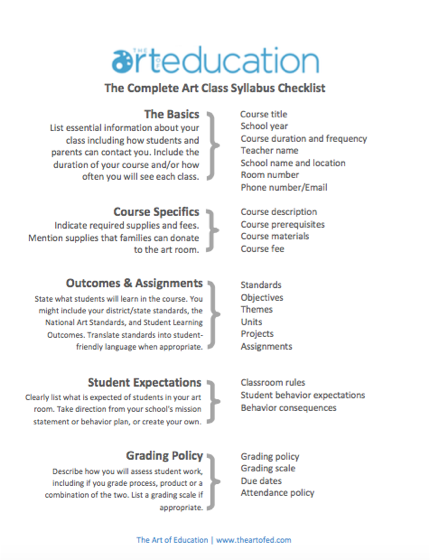
There is one thing that I always dread on the first day of school… explaining the class syllabus. There is something so mundane about reading a repetitive, lackluster document to your students. We should be celebrating the start of a new school year with a creative project, not painstakingly going over each SLO for the next semester. The truth is, so many of us are required to provide a syllabus for each of our courses. And in reality, it is necessary for students (and parents) to understand our expectations.
Why not create a class syllabus that is aesthetically pleasing and informative? Imagine a document that is engaging to read and communicates significant information. Enter the visual syllabus!
Want to try your hand at a visual syllabus?
Here are 3 helpful tips.
1. Limit Your Text
Traditionally, syllabi have paragraphs of information that students have to sift through. A visual syllabus breaks down the information into digestible parts. Think about what parts of your syllabus need to stay. Essential items like your contact info, course description, and course materials will need to find a way into your new design. Take a look at The Complete Art Class Syllabus Checklist below to help you plan.
2. Organize Your Info
Using a layout that breaks the document into sections, add your course information. Consider using bold fonts to point out clear expectations and bullets to keep things concise. When adding in your SLOs or “I can” statements, make sure the integrity of the standards stays. Substitute student-friendly language only when needed. In my example, I left the National Anchor Standards as is. Not only does this give me the opportunity to explain them to my students, but it also provides some new vocabulary words for class discussion.
3. Add Some Flare
Don’t forget to add some images. These could provide visual interest or even explain concepts. For example, include a pie chart that clarifies your grading scale or explain your supply list with drawn illustrations of the materials. If you have extra room, add in something fun about yourself. A simple sentence or photo about who you are can create a personal connection with students.
Remember to include only essential information when revamping your syllabus. Keep the design simple and clean, but add some images to create interest. Revising a boring syllabus into an appealing handout can make a genuine impact on the first day of class and keep YOU awake as you are explaining it for the umpteenth time.
Are you required to provide a class syllabus?
How do you keep it interesting for students?
 This article was written by AOE Content Director Tracy Hare. Tracy teaches middle school art for a small district in central Minnesota. Tracy received her M.Ed. from the University of Minnesota and strives to deepen her students’ 21st century skills by encouraging them to practice critical thinking, solve open-ended problems creatively and work together to produce, connect and share their artwork.
This article was written by AOE Content Director Tracy Hare. Tracy teaches middle school art for a small district in central Minnesota. Tracy received her M.Ed. from the University of Minnesota and strives to deepen her students’ 21st century skills by encouraging them to practice critical thinking, solve open-ended problems creatively and work together to produce, connect and share their artwork.

